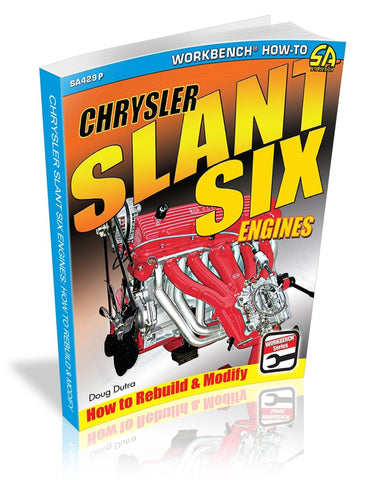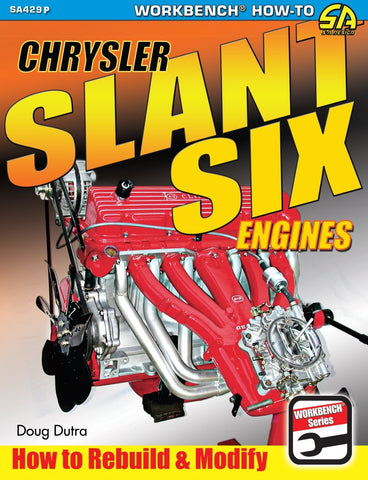The photos in this edition are black and white.
Use expert advice to rebuild your Slant Six engine to make it run like it did on the showroom floor - or modify it to perform even better.
Author Doug Dutra walks you through every aspect of disassembly, evaluation, rebuild, and reassembly in an easy-to-read, step-by-step format. The book also covers modifications, showing how to squeeze the most out of your engine.
The year 1960 was an important one in auto manufacturing; it was the year all of the Big Three unveiled entrants in a new class of car called the compact. Chrysler's offering, the Plymouth Valiant, was paired with its redesigned 6-cylinder engine entrant, the Slant Six, known by its nickname the “leaning tower of power.” This engine powered the Valiants when they swept the top seven positions in the newly christened compact race that precluded the Daytona 500. With its legacy intact, Chrysler's Slant Six-powered Mopar automobiles were offered for decades to come in three displacement offerings (170, 198, 225).
With millions of Slant Six engines built over the 30-plus years that the engine was produced, it’s always a good idea to have this book handy, as you never know when the next “leaning tower of power” will find its way into your garage.r
Acknowledgments
About the Author
Foreword by Steve Magnante
Introduction
Chapter 1: Chrysler Slant Six History
Initial Engine Design Work
The Die-Cast Aluminum-Block 225 Program
Engine Identification
Casting Numbers
Decoding Engine Block ID Stampings
Chapter 2: Engine Tuning, Evaluation, and Diagnosis
Mechanical Lifter Valve Lash
Ignition System and Valve Timing Checks
Ignition Timing
Oil Pressure and Compression Testing
Chapter 3: Accessory and Engine Removal
Safety First
Getting Started
Removing Accessories
Engine Removal
Chapter 4: Engine Disassembly
Parts Removal
Disassembly Inspection and Measurements
Take Your Time!
Chapter 5: Block Inspection, Preparation, and Cleaning
Inspection
Deburring and Preparation
Cleaning
Chapter 6: Short-Block Assembly
Assembly Area and Operations
Painting
Wash Out Remaining Debris
Reassemble the Slant Six
Chapter 7: Cylinder Head Assembly
Inspecting Valve Seats and Guides
Deburring, Oil Drainback, Milling, and Porting
Valve Guide, Seat, and Grinding Work
Cylinder Head Assembly
Chapter 8: Final Long-Block Engine Assembly
Sheet Metal Installation
Expansion and Pipe Plugs
Cylinder Head Installation
Rocker Arm Assembly
Intake and Exhaust Manifold Installation
Water, Fuel, and Oil Pump
Damper, Brackets, and Mounts
Chapter 9: Engine Installation and Start-Up
TorqStorm Kit Contents
TorqStorm Supercharger Installation
Supercharger Kit Install Tips
Supercharger Testing
Summary
Epilogue
Appendix
Source Guide
The photos in this edition are black and white.
Use expert advice to rebuild your Slant Six engine to make it run like it did on the showroom floor - or modify it to perform even better.
Author Doug Dutra walks you through every aspect of disassembly, evaluation, rebuild, and reassembly in an easy-to-read, step-by-step format. The book also covers modifications, showing how to squeeze the most out of your engine.
The year 1960 was an important one in auto manufacturing; it was the year all of the Big Three unveiled entrants in a new class of car called the compact. Chrysler's offering, the Plymouth Valiant, was paired with its redesigned 6-cylinder engine entrant, the Slant Six, known by its nickname the “leaning tower of power.” This engine powered the Valiants when they swept the top seven positions in the newly christened compact race that precluded the Daytona 500. With its legacy intact, Chrysler's Slant Six-powered Mopar automobiles were offered for decades to come in three displacement offerings (170, 198, 225).
With millions of Slant Six engines built over the 30-plus years that the engine was produced, it’s always a good idea to have this book handy, as you never know when the next “leaning tower of power” will find its way into your garage.r
Acknowledgments
About the Author
Foreword by Steve Magnante
Introduction
Chapter 1: Chrysler Slant Six History
Initial Engine Design Work
The Die-Cast Aluminum-Block 225 Program
Engine Identification
Casting Numbers
Decoding Engine Block ID Stampings
Chapter 2: Engine Tuning, Evaluation, and Diagnosis
Mechanical Lifter Valve Lash
Ignition System and Valve Timing Checks
Ignition Timing
Oil Pressure and Compression Testing
Chapter 3: Accessory and Engine Removal
Safety First
Getting Started
Removing Accessories
Engine Removal
Chapter 4: Engine Disassembly
Parts Removal
Disassembly Inspection and Measurements
Take Your Time!
Chapter 5: Block Inspection, Preparation, and Cleaning
Inspection
Deburring and Preparation
Cleaning
Chapter 6: Short-Block Assembly
Assembly Area and Operations
Painting
Wash Out Remaining Debris
Reassemble the Slant Six
Chapter 7: Cylinder Head Assembly
Inspecting Valve Seats and Guides
Deburring, Oil Drainback, Milling, and Porting
Valve Guide, Seat, and Grinding Work
Cylinder Head Assembly
Chapter 8: Final Long-Block Engine Assembly
Sheet Metal Installation
Expansion and Pipe Plugs
Cylinder Head Installation
Rocker Arm Assembly
Intake and Exhaust Manifold Installation
Water, Fuel, and Oil Pump
Damper, Brackets, and Mounts
Chapter 9: Engine Installation and Start-Up
TorqStorm Kit Contents
TorqStorm Supercharger Installation
Supercharger Kit Install Tips
Supercharger Testing
Summary
Epilogue
Appendix
Source Guide






